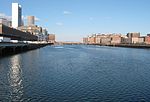Fort Point Channel Historic District
Historic districts in Suffolk County, MassachusettsHistoric districts on the National Register of Historic Places in MassachusettsNRHP infobox with nocatNational Register of Historic Places in BostonSeaport District

The Fort Point Channel Historic District is an historic district located along Congress, Summer and A streets in South Boston on the south side of Fort Point Channel. The district includes the Boston Children's Museum (pictured, right), located in a renovated 19th-century brick industrial building, and the Boston Fire Museum, housed in the 1891 Congress Street Fire Station.
Excerpt from the Wikipedia article Fort Point Channel Historic District (License: CC BY-SA 3.0, Authors, Images).Fort Point Channel Historic District
Congress Street, Boston South Boston
Geographical coordinates (GPS) Address Nearby Places Show on map
Geographical coordinates (GPS)
| Latitude | Longitude |
|---|---|
| N 42.351111111111 ° | E -71.050555555556 ° |
Address
303 Congress Street
Congress Street 303
02210 Boston, South Boston
Massachusetts, United States
Open on Google Maps








